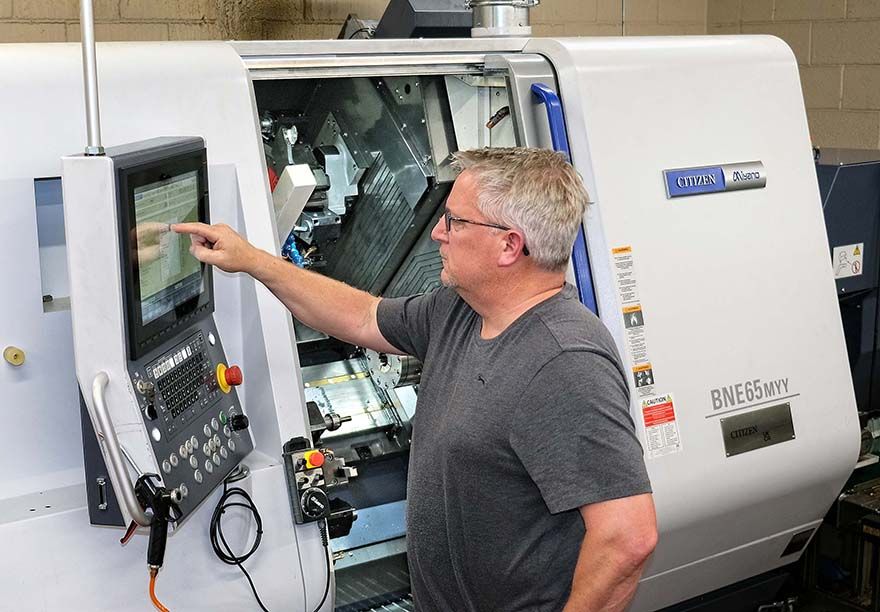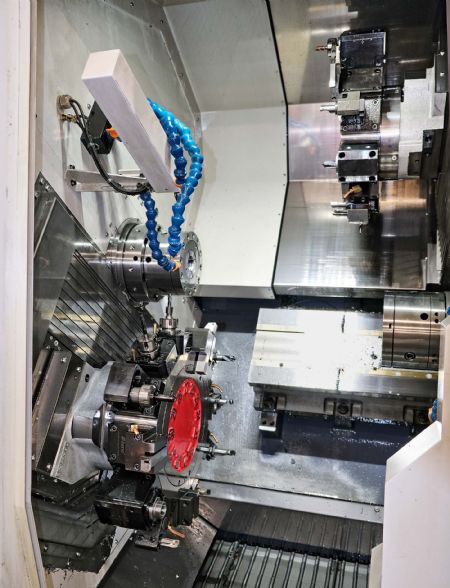 John Cable, owner of C&M Precision, with one of the new Miyano BNE-65MYY fixed-head lathes on the shopfloor in Maldon
John Cable, owner of C&M Precision, with one of the new Miyano BNE-65MYY fixed-head lathes on the shopfloor in MaldonA large proportion of work going through Maldon-based sub-contractor
C&M Precision’s factory involves machining copper bar fed into CNC mill-turn lathes. Two sliding-head models out of the nine turning centres on the shopfloor, all of which have been supplied by
Citizen Machinery UK, have LFV (low frequency vibration) functionality in the operating system of their Mitsubishi controls. It results in much higher productivity and increased yield when converting malleable copper into high-end electronic components for OEMs in the medical, radar, satellite and broadcasting sectors.
Owner John Cable explained that for many of these jobs, a particular grade of copper known as OFHC (oxygen-free high conductivity) has to be used, which is more than 99% pure. One 60mm long, tight-tolerance component previously produced from 3mm dia bar on an early Citizen Cincom M16 slider without LFV had to be turned in one pass through the guide bush down to 1.20-1.22mm dia along half its length. The continuous string of copper swarf frequently damaged the component and often became lodged in the counter spindle, preventing synchronous transfer after part-off and causing the machine to alarm out. Productivity was severely impacted and up to 20% of parts had to be scrapped.
Mr Cable said: “Transferring the job to a Cincom L12-VIILFV we bought in 2019 was a real winner. With the LFV function turned on, the copper chips like brass. Yield is now 100%, throughput is high and we can even leave the machine to run unattended.”
Chip-breaking functionalityThe other Cincom slider on site with this chip-breaking functionality, a nominally 20mm capacity L20-VIIILFV, arrived on the shopfloor in 2017, making the sub-contractor an early adopter of this novel technology. Supplied with a kit that allows feeding of oversize bar up to 25mm dia, the lathe is also proving useful for machining other materials that tend to generate stringy swarf, like nickel alloys and plastics, which are regularly turned in the Maldon facility.
C&M Precision was established in 1992 as a CNC sliding-head, twin-spindle, mill-turning shop, following research at the time indicating that four-fifths of rotational parts produced in the UK were less than 25mm in dia. After starting out with a different brand of slider, Mr Cable quickly changed to Cincoms, describing the transition as ‘a breath of fresh air’.
The first model to arrive in 2001 was a now discontinued M12, which has been sold on. The first job it tackled was the production of 120,000 brass connectors requiring the milling of 3/8in hex flats. Amazingly, due to the rigidity of the lathe that Mr Cable described as ‘rock solid’, one 6mm dia carbide milling cutter completed all of the flats, 720,000 of them, and still had not worn out.
 Pictured right: Machining area of the Miyano BNE-65MYY, with Y-axis turrets above and below the spindle centreline
Pictured right: Machining area of the Miyano BNE-65MYY, with Y-axis turrets above and below the spindle centrelineThe sub-contractor is an enthusiastic user of Cincom M-series machines due to their inclusion of a tool turret as well as a gang tool post, allowing the production of complex components. A 16mm dia bar model installed in 2004 was joined three years later by a pair of 32mm dia bar capacity lathes. The latter, third-generation M32 lathes have since been replaced by fifth-generation models to take advantage of Y-axis motion on the turret and an overall higher specification.
2014 and 2015 saw the arrival of three more 32mm sliders, this time in the Cincom A-series. They have only gang tool posts, so are faster when manufacturing less complicated parts. One of the lathes does not have a guide bush, as it is devoted to relatively limited runs of short components such as mining industry connectors. The other two sliders with a guide bush produce tens of thousands of parts per week, 24/5. One example is a mild steel gas meter part which the customer orders at a rate of one million per year, with the sub-contractor making weekly deliveries.
C&M Precision’s latest two acquisitions are from Citizen’s Miyano range of fixed-head lathes. Installed in January and March 2022 respectively, the twin-turret BNE-65MYY models with Y-axis motion on each tool carrier replaced two ageing lathes that had one Y-axis turret apiece.
Mr Cable continued: “It made sense to go the Miyano route in view of our good experience with the Cincom lathes. People say it is not good to have all your eggs in one basket, but in Citizen’s case it is. We now have a single point of contact for applications, backup and service and the supplier is very capable and responsive to our needs.”
Highly productiveHe added that the Miyano lathes have similar capability at both spindles and are highly productive, with advantage taken of Y-axis machining for a large proportion of the time. Simple off-centre holes are frequently drilled and bored, flats are easier to mill up to a shoulder and roll marking is often done using the Y-axes. Parts coming off the lathes are accurate due to one-hit production. It is possible to program cycles involving superimposed machining, where three tools are cutting simultaneously, although this facility has not been used so far in the Maldon factory.
Some parts could not be produced at all on driven-tool lathes without Y-axis motion on at least one turret and would have to be put onto a machining centre for a second operation. Others, such as a pair of components — one aluminium and the other brass — for a broadcasting microphone, are produced much faster on the twin Y-axis Miyanos compared with the lathes they replaced. The more complex of the two, the aluminium part, is produced in 4.5min compared with 7.5min previously. As batch size is 2,000-off, the saving is considerable.
As to the future, Mr Cable sees continued purchase of LFV lathes inevitable. While high-pressure coolant systems break swarf adequately on his current larger lathes, as they mainly process free-cutting materials, there is one job presently produced from malleable, oversize, Swedish iron bar on the L20-VIIILFV that would profit from being put onto a 32mm Cincom in the same series with the chip-breaking technology.